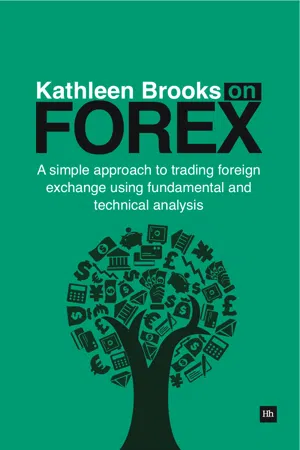
Kathleen Brooks on Forex
A simple approach to trading foreign exchange using fundamental and technical analysis
- 140 pages
- English
- ePUB (mobile friendly)
- Available on iOS & Android
Kathleen Brooks on Forex
A simple approach to trading foreign exchange using fundamental and technical analysis
About this book
A simple approach to successful forex tradingMany foreign exchange traders use either fundamental analysis or technical analysis and they're often considered to be mutually exclusive approaches. But FX does not have to be traded that way - fusing the two types of analysis will improve your research and, more importantly, your trading results.This is how Kathleen Brooks trades foreign exchange and she has found it to be extremely successful. In Kathleen Brooks on Forex she reveals the secrets of this approach, demonstrating the indicators she uses, and showing through detailed examples how she plans and executes profitable trades.At the heart of Kathleen's trading philosophy is the principle that fundamental factors - politics, economics and societal changes - cause currency prices to move in the medium to long term (and sometimes in the strangest ways), but throughout the day the price movements are based upon technical factors. Building a trading plan around the two sets of factors works for her and by reading about how she does her pre-trade market analysis (the homework), forms a trading plan and puts the plan into action, you will see how to apply this principle in practice in your own trading.The book is divided into four sections:- Part A - using fundamental indicators to gain an impression of the market- Part B - using technical indicators to refine your trading plan- Part C - fusing fundamental and technical analysis to select trades- Part D - revealing Kathleen's risk management techniquesKathleen's description of her method, and ideas on how you can use it too, will appeal to anyone who wants to learn more about how to trade foreign exchange as well as those already in the market looking for a fresh approach. Blissfully free of rhetoric, written in an accessible personal style and punctuated with anecdotes from Kathleen's unique career in the markets, this is a new and refreshing look at foreign exchange.
Frequently asked questions
- Essential is ideal for learners and professionals who enjoy exploring a wide range of subjects. Access the Essential Library with 800,000+ trusted titles and best-sellers across business, personal growth, and the humanities. Includes unlimited reading time and Standard Read Aloud voice.
- Complete: Perfect for advanced learners and researchers needing full, unrestricted access. Unlock 1.4M+ books across hundreds of subjects, including academic and specialized titles. The Complete Plan also includes advanced features like Premium Read Aloud and Research Assistant.
Please note we cannot support devices running on iOS 13 and Android 7 or earlier. Learn more about using the app.
Information
PART A – Fundamental Analysis
Introduction
- Which economies in the world are growing?
- Is the growth healthy and sustainable?
- What are governments and central banks doing to manage their economies?
- What is the political situation?
Trading using economic data
Use of an economic calendar
Consensus
Economic indicators
- Labour market surveys
- Purchasing Managers Index (PMI) surveys and Institute for Supply Management (ISM) surveys
- Inflation data
- Quarterly GDP
1. Labour market surveys
What is it?
When is NFP data released?
Why is NFP data significant?
FX market example
Table of contents
- Cover
- Publishing details
- Acknowledgements
- About the author
- Preface
- Introduction
- PART A – Fundamental Analysis
- PART B – Technical Analysis
- PART C – The Fusion Philosophy
- PART D – Risk Management
- Conclusion